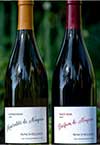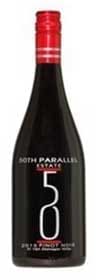 “Our life is frittered away by detail,” proclaimed Henry David Thoreau. “Simplify, simplify, simplify!”
“Our life is frittered away by detail,” proclaimed Henry David Thoreau. “Simplify, simplify, simplify!”
On Thanksgiving, many of us heed Thoreau’s advice and remind ourselves and our loved ones to stop fretting over little things and give thanks for the big things we too often take for granted.
Yet, one area that seems to defy the transcendentalist’s appeal is the choice of wine to pair with the turkey and all its accoutrements. Every Thanksgiving, pundits descend on the blogosphere to proffer advice on how to choose the perfect wine for the occasion, reiterating “rules” for pairing to guarantee success. It does not help that the experts often contradict one another, with one suggesting a crisp white like Sauvignon Blanc and another adamant that an oaky California Chardonnay is just the ticket.
Food and wine pairing, in general, has become unnecessarily overcomplicated. Consumers are led to believe that rules must be learned and obeyed when nothing could be further from the truth. In fact, choosing wine pairings is as much about the fun of experimentation as it is about aligning flavour profiles – especially during Thanksgiving dinner when the focus should be on company and conversation.
 Thus, if I were to curate a set of rules for Thanksgiving wine pairing, the first and only would be that there are no rules, only guidelines. A few of my own suggested guidelines and selections follow, but these, like all others, should always be subordinated to personal preference. No one needs to wince through a wine they find unpalatable in order to achieve maximum complementarity with a given dish. If your choice of wine clashes with the food to the point of making it unpleasant (a rare occurrence), a sip of water and a bite of bread when moving between plate and glass will, in most cases, sufficiently cleanse the palate, allowing you to enjoy both the meal and the wine in their own right.
Thus, if I were to curate a set of rules for Thanksgiving wine pairing, the first and only would be that there are no rules, only guidelines. A few of my own suggested guidelines and selections follow, but these, like all others, should always be subordinated to personal preference. No one needs to wince through a wine they find unpalatable in order to achieve maximum complementarity with a given dish. If your choice of wine clashes with the food to the point of making it unpleasant (a rare occurrence), a sip of water and a bite of bread when moving between plate and glass will, in most cases, sufficiently cleanse the palate, allowing you to enjoy both the meal and the wine in their own right.
Since it is highly unlikely anyone will ruin a meal with a bad pairing, my first guideline for choosing Thanksgiving wines is simply to have fun with it. Nothing saps the pleasure out of wine like stressing about it. This does not mean you have license to cause undue suffering by serving homebrew Merlot; just avoid the urge to intellectualize the effort by choosing one wine for cranberry sauce and another for stuffing.
Second, have a few different options available. Your guests will likely have different palates, so it’s always a good idea to have both red and white on hand, as well as sparkling wine, both as an aperitif to kick things off and for those Churchillians in your group who enjoy bubbles throughout the meal.
Third, serve wines at the right temperature (this one, I admit, is closer to a rule). Sparkling and white wine should be chilled in the fridge or an ice bucket – not ice cold as this restrains aromas, but cold enough to be refreshing. Reds should be cellar temperature, around 16 to 18 degrees, not the balmy 22 degrees of the typical room. There is some nuance here: lighter wines are typically served colder than full-bodied wines, but it’s always better to pour a slightly too cold wine as it will quickly warm up in the glass.
And finally, even if the wine is corked and the turkey charred, keep in mind the purpose of the holiday – to give thanks for the many comforts and opportunities we enjoy simply by living where we live. The fact that there is wine on the table is more important than how well it pairs with the bird. Ensure there is enough, and you won’t go wrong.
Yule’s Picks for Thanksgiving Wines
Sparkling:
 Good quality Champagne. Avoid the cheapest bottle, as low-quality Champagne is often overpriced, but even standard Veuve Clicquot Brut is a great choice. If Champagne is beyond your budget, Spanish Cava is a great alternative, as is any traditional method bubbly from a cool climate.
Good quality Champagne. Avoid the cheapest bottle, as low-quality Champagne is often overpriced, but even standard Veuve Clicquot Brut is a great choice. If Champagne is beyond your budget, Spanish Cava is a great alternative, as is any traditional method bubbly from a cool climate.
Local option: Canada makes some excellent traditional method sparklers. Try Benjamin Bridge or Blomidon from Nova Scotia or Blue Mountain from the Okanagan.
White:
 Unoaked or lightly oaked Chardonnay. Chablis or white Burgundy would be my preference, but a similar style from South Africa’s Hemel en Aarde Valley, Chile’s Casablanca Valley, or Australia’s Tasmania will work just as well.
Unoaked or lightly oaked Chardonnay. Chablis or white Burgundy would be my preference, but a similar style from South Africa’s Hemel en Aarde Valley, Chile’s Casablanca Valley, or Australia’s Tasmania will work just as well.
Local option: Cool-climate Ontario is well-suited to Chardonnay. Try Bachelder’s single-vineyard bottlings from Beamsville (Niagara) or Rosehall Run from Prince Edward County.
Red:
 Cool-climate Gamay or Pinot Noir. Cru Beaujolais (e.g. Morgon) will go with everything on the Thanksgiving table and is generally much more affordable than Burgundian Pinot Noir, although red Burgundy would also be a great choice. Avoid jammy Pinot Noirs from warmer parts of California or Australia.
Cool-climate Gamay or Pinot Noir. Cru Beaujolais (e.g. Morgon) will go with everything on the Thanksgiving table and is generally much more affordable than Burgundian Pinot Noir, although red Burgundy would also be a great choice. Avoid jammy Pinot Noirs from warmer parts of California or Australia.
Local option: The Niagara Escarpment is great for elegant Pinot and Gamay, with Malivoire, Hidden Bench, and Tawse all producing lovely examples. Alternatively, try 50th Parallel (Okanagan).
Yule is COO of InVintory, an innovative wine collecting app based in Toronto. With an extensive background in wine, from working at a winery to managing private cellars, she aims to demystify the world of wine, helping people proceed through it with confidence and thereby unlock the pleasure that this ancient tradition can offer. For interview requests, click here.
The views, opinions and positions expressed by columnists and contributors are the authors’ alone. They do not inherently or expressly reflect the views, opinions and/or positions of our publication.
© Troy Media
Troy Media is an editorial content provider to media outlets and its own hosted community news outlets across Canada.


